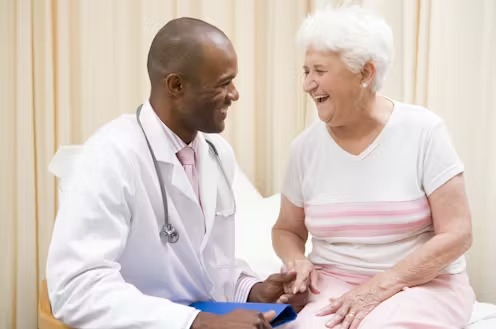There is no doubt that primary care in the UK – the services that provide the first point of contact in the healthcare system, such as general practice – isn’t working.
Patients report difficulties in making appointments and seeing the same GP. Continuity of care is an important factor in patient outcomes, particularly for older adults with comorbidities – those living with more than one long-term condition, such as diabetes or asthma.
Research shows that patients who see the same doctor have fewer hospital admissions and lower mortality rates. However, we also know that people on the lowest incomes have much more difficulty getting GP appointments. And when they do, they are much more likely to have a much worse experience than those who’re more financially comfortable.
Evidence shows that, in particular, older adults who live in poorer areas struggle to access the primary care that they need. They already have poorer health outcomes, and their life expectancy is lower those living in more affluent areas – yet GP services are not providing the help they should.
Access to general practice is vital to maintaining good public health. It’s the entry point to the national health care system, and accounts for around 90% of all patient contact with the NHS.
But overall patient satisfaction with general practice seems to be in sharp decline. Between 2021 and 2023, the percentage of patients reporting a good overall experience fell from 71% to 55%.
The reasons for this apparent crisis in confidence have been covered widely in the media. But reports have tended to focus on GPs rather than the patients who’re most affected.
For example, it’s been widely reported that the number of GPs has fallen 4%-5% in recent years and many doctors who remain in general practice report feeling stressed and over-worked. It’s no wonder, then, that a significant proportion of GPs have opted to reduce their hours.
There aren’t enough general practitioners to meet growing demand, especially for the complex needs of an aging population.
But what of the people disproportionately affected by the crisis in general practice?
Older, impoverished adults disproportionately affected
As life expectancy in the UK increases, the role of general practice in keeping people well and living independently is crucial. This is particularly true in older patients with comorbidities. The often complex nature of their conditions means that these patients need regular monitoring and access to GP services.
In addition, older adults with comorbidities are often socially isolated, and the human contact provided by the therapeutic relationship developed through regular appointments is considered vital to their wellbeing.
Research has highlighted that the ongoing relationship between GP and patient is particularly important in this group of patients.
However, the continuity of care traditionally provided by the family doctor has declined as primary care struggles to meet the demands placed upon it. In these situations, the influence of education and social class on health becomes increasingly apparent.
A 2024 survey by NHS watchdog Healthwatch found that already well established links between poverty and ill health are exacerbated by barriers to obtaining healthcare.
The report, which surveyed a representative sample of the population – 2,018 people aged over-16 in England – found that those in poverty were twice as likely to experience problems getting to see a GP than those who identified as “very comfortable” financially.
Louise Ansari, Healthwatch’s chief executive, suggested that the survey’s findings were a warning that the NHS could be moving toward a “two-tier service” with ease of access closely related to wealth.
Ansari’s concerns seem to be well-founded. In more affluent, middle class areas, the quality of general practice is often better and more readily available, often because practices have fewer patients.
Wealthier areas tend to have more highly educated populations, who tend to be more confident in requesting appointments and articulating their health concerns.
Conversely, people living in less affluent areas with greater levels of deprivation may not always be aware of what they are entitled to, or how to get it.
Delays in seeking help
The move to remote consultations is another aspect of the barriers to access faced by those who’re most socially and financially disadvantaged.
While remote consultation may be appropriate and perfectly satisfactory, even preferable, for many patients, there are people – often from the most deprived groups – who are digitally excluded (unable to use the internet in ways that are needed to participate fully in modern society) and do not have the resources to access virtual appointments.
But this lack of easy access for all patients is at odds with public health messaging.
For example, public health campaigns that target older adults, emphasise the importance of early detection of cancer: “if something doesn’t feel quite right … get it checked out”. Early detection and survival rates in all types of cancer are inextricably linked.
However, difficulty accessing a GP appointment means that people are more likely to put off and delay seeking help with their symptoms. The number of late presentations for cancer in particular means that long term survival rates from cancer are not as good as they should be.
The UK’s ageing population and the recent sharp rise in the cost of living means the number of disadvantaged older people in need of consistent, high quality GP care is rising. But their chance of getting it seems to be ever dwindling.



 Personalized cancer treatments based on testing drugs quickly leads to faster treatment, better outcomes
Personalized cancer treatments based on testing drugs quickly leads to faster treatment, better outcomes  Can a drug like Ozempic help treat addictions to alcohol, opioids or other substances?
Can a drug like Ozempic help treat addictions to alcohol, opioids or other substances?  The politics stopping the UK from opening a youth mobility scheme with Europe
The politics stopping the UK from opening a youth mobility scheme with Europe  Eating some chocolate really might be good for you – here’s what the research says
Eating some chocolate really might be good for you – here’s what the research says  Gut microbiome: meet Roseburia intestinalis — the energy-producing bacterium that helps us fight against disease
Gut microbiome: meet Roseburia intestinalis — the energy-producing bacterium that helps us fight against disease  Eye infections might seem like a minor complaint – but in some cases they can cause blindness and even death
Eye infections might seem like a minor complaint – but in some cases they can cause blindness and even death  Why is China risking US sanctions by arming Russia?
Why is China risking US sanctions by arming Russia?  Does ejaculating often reduce your risk of prostate cancer?
Does ejaculating often reduce your risk of prostate cancer?  Sudan’s civil war is rooted in its historical favouritism of Arab and Islamic identity
Sudan’s civil war is rooted in its historical favouritism of Arab and Islamic identity  Good for your health and the environment: why we should be eating oily fish
Good for your health and the environment: why we should be eating oily fish  Honey is said to help with hay fever symptoms – here’s what the research says about this claim
Honey is said to help with hay fever symptoms – here’s what the research says about this claim  How to look after your mental health while packing up Mum or Dad’s home
How to look after your mental health while packing up Mum or Dad’s home  Vaping now more common than smoking among young people – and the risks go beyond lung and brain damage
Vaping now more common than smoking among young people – and the risks go beyond lung and brain damage  Nigerians throw naira notes around to show love: but it could land you in jail
Nigerians throw naira notes around to show love: but it could land you in jail 































